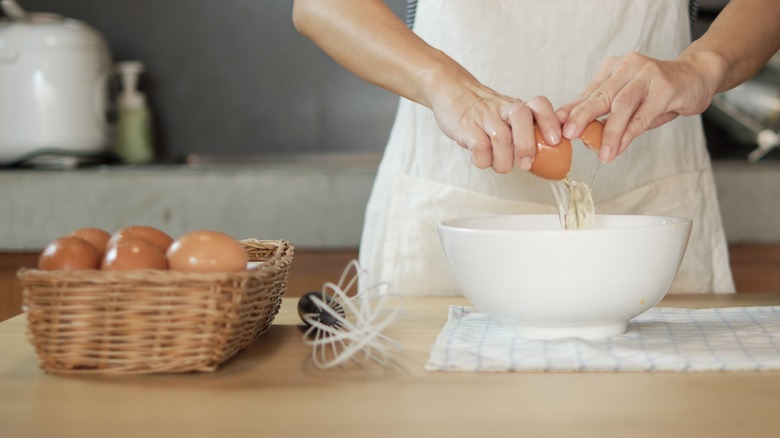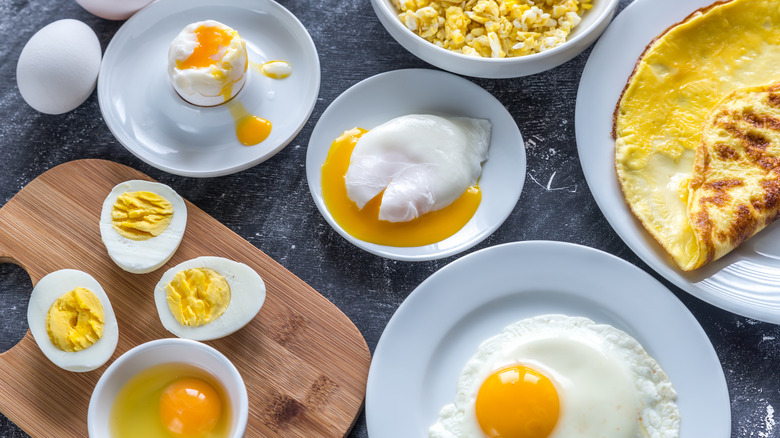The Best Way To Keep The Yolk Intact When Frying Eggs
Everyone's idea of a perfect breakfast varies. For some, it's a feast fit for the royals, filled with cereal, orange juice, pancakes, sausage, and eggs. For others, it's a side of scrambled paired with buttered toast – maybe a slice or two of bacon. But no matter how extravagant or simple you enjoy your morning meals, one item remains the common denominator in every scenario: eggs.
Compared to traditional breakfast proteins, such as bacon or sausage, eggs are a relatively healthy option. They offer a high source of protein that provides energy and a feel-full sensation throughout the day. They are also packed with vitamins that aid in vision and maintain your cells' health. And with their vast design and cooking versatility, they are a great addition that never becomes too boring. But where did our long-term connection between eggs and breakfast stem from? We have the Industrial Revolution to thank for that.
Although our fascination with eggs originates far before that, they became increasingly popular throughout the 19th century. They were inexpensive compared to other available proteins and supplied an adequate amount of energy to help workers throughout the day. But as our breakfasts evolved, so did the way we eat them. Chances are, if you're not a fan of scrambled or fried, you're likely a sunny-side-up or over-easy person – that is, until the yolk breaks. There's truly nothing worse than when that center of liquid gold unintentionally oozes out. Fortunately, there are some ways to prevent this from happening.
Stick to a flat surface for egg-cracking
The first step in ensuring your yolk stays intact is finding the best surface to crack it on. And we don't mean the lip of a bowl or the edge of a pan – these can actually increase your chances of loose shell fragments – but rather a flat surface. Your egg should effectively crack with one strike, requiring you to only press lightly with your thumbs against the seam to break it open and release the contents inside. It's always good practice to place these gooey innards in a bowl before sliding them into a frying pan to ensure that no foreign objects are swimming around.
Temperature plays a vital role in any food you cook. High heat can make your eggs parched rather than poached, leaving you with runny inner whites and withered edges. Instead, fry your eggs on medium heat. This will ensure it simmers evenly without the chance of over or under-cooking. For extra flavor with fewer calories, swap butter for cold-pressed olive oil. Olive oil is a wonderful element to fry with, especially for its nutritional fatty acids. Manual preparation is key for any egg-venture. However, having the proper tools is equally important. Many professional chefs, including Gordon Ramsay, prefer using a non-stick pan for frying delicate foods such as eggs. And while it's up to the cook's discretion to use the lid, this tool is heavily recommended to aid in an evenly fried and timely cooked egg.
The difference between poached, sunny-side-up, and over-easy
One of the most nerve-wracking questions in a restaurant is: "How would you like that cooked?" It's worse than choosing between two sides or deciding if that extra basket of bread is worth it (the answer is always yes). Do you really want that steak well done, or will you live on the edge with medium well? And when it comes to eggs, it can cause an existential crisis in the middle of a Denny's, specifically for runny-yolk lovers. Sunny-side-up, poached, and over-easy (don't get us started on over-medium) all sound great in theory, but what's the difference between the three?
Besides scrambled, sunny-side-up is the most traditional type of egg. You probably see it in breakfast ad campaigns, emojis, or picturesque early-morning meals. It's identified by the bright orange yolk placed delicately on top of a halo of egg whites. Flipping is unnecessary for sunny-side-up; these are often cooked with a sealed lid so the steam cooks them thoroughly. Doing so would turn them into over-easy eggs, which require one flip midway through. For a less runny yolk, leave them for a few extra minutes to make over-medium (not as runny) and over-hard (solid yolk). Last but not least is poached. These slightly resemble uncooked hard-boiled eggs but without the shell. Poached eggs are made in simmering water, where the heat cooks the exposed egg whites and yolk. They are definitely picture-worthy and are a unique twist to traditionally styled eggs.


